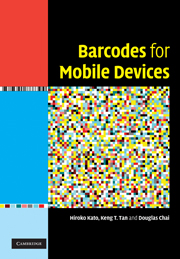Book contents
- Frontmatter
- Contents
- Preface
- 1 Introduction
- 2 Barcode technology evolution
- 3 Two-dimensional barcode for mobile phones
- 4 Evolution of barcode applications
- 5 Technologies for enhancing barcode robustness
- 6 A prototype colour 2D barcode development
- 7 Evaluation of the prototype colour 2D barcode
- Appendices
- References
- Index
- Plate section
1 - Introduction
Published online by Cambridge University Press: 06 July 2010
- Frontmatter
- Contents
- Preface
- 1 Introduction
- 2 Barcode technology evolution
- 3 Two-dimensional barcode for mobile phones
- 4 Evolution of barcode applications
- 5 Technologies for enhancing barcode robustness
- 6 A prototype colour 2D barcode development
- 7 Evaluation of the prototype colour 2D barcode
- Appendices
- References
- Index
- Plate section
Summary
Overview of barcode technology
First of all, it is important to know the relationship between a ‘code’ and a ‘symbol’ in this context:
The shorthand used to represent the verbal description of an item is called the product identification code. The product identification code is shortened to the word ‘code’. The use of the word ‘code’ should not be confused with the barcode, which is technically called the symbol. A barcode symbol is used to identify people and places as well as a product [1, p. 44].
Definition of barcode
The definition of a barcode is given in the International Organization for Standardization and the International Electrotechnical Commission (ISO/IEC 1976 2–2): Information technology –Automatic identification and data capture (AIDC) techniques – Harmonised vocabulary – Part 2: Optically readable media (ORM). Since it only includes onedimensional barcodes, the definition given by the Japanese Standards Association (JSA) is preferred.
Abarcode is a machine-readable representation of information that is formed by combinations of high and low reflectance regions of the surface of an object [2], which are converted to ‘1’ s and ‘0’ s. This definition includes both one-dimensional and twodimensional barcodes. Originally, information was encoded into an array of adjacent bars and spaces of varying width and that is where the word ‘barcode’ is derived from. This type of barcode is called a linear one-dimensional (1D) barcode. The 1D barcode symbologies can be read by a scanner that sweeps a beam of light across the barcode symbol in a straight line [2].
- Type
- Chapter
- Information
- Barcodes for Mobile Devices , pp. 1 - 10Publisher: Cambridge University PressPrint publication year: 2010



